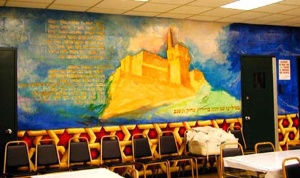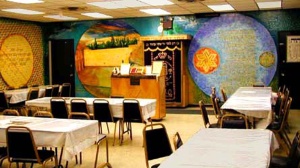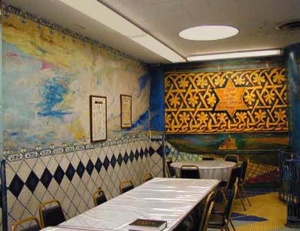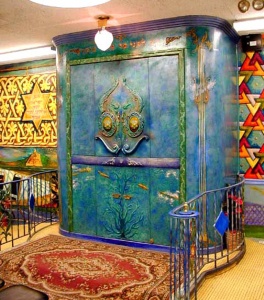The Painted Shul

In 1978, almost a year after Archie Rand had finished the upstairs murals at the B’nai Yosef synagogue in Brooklyn, he was invited to create additional murals downstairs in the two study halls. The pomp and ceremony of the Holidays and Sabbaths were represented upstairs in an open and expansive space, but downstairs was a weekday, down-to-earth affair. In these rooms, enclosed and intimate, there was a constant flow and presence of male Jews in over ten consecutive minyans conducted every morning, noon and evening. The study hall, occupied all day by men learning Torah, is the creative hub of Torah knowledge in this and every synagogue complex. In this different environment Rand altered his aesthetic strategy. What he created was a sanctuary of security and beauty.

In the first Beit Medrash (study hall) the overall design is amazingly uniform for Rand. A series of four large mandalas containing holy texts or landscape images dominate the room and flank the simple Torah ark. Delicate blues, purples and pinks contrast gently with soothing greens and earth colors. The room is unified by a series of circles and arches. The mandala of the Western Wall to the left of the ark is balanced by an enormous depiction of the Tomb of the Patriarchs in Hebron at the back of the room. Prayer and study seem secure and protected in the imagined geographical space.
Unity and focus increase exponentially in the second Beit Medrash across the hall. The side walls are simple Monet-like evocations of water and sky, lending an aura of primeval peace. The Torah ark is framed by bold patterns based on the Magen David. To the left a hanging golden latticework proclaims “Shema Yisroel” before a landscape of the future Temple. The right is dominated by the glowing meditation “As for me, through Your abundant kindness I will enter Your House…” All around the top of the walls that enclose the room is a faint but persistent text. It is the final prayer of every service, “Aleinu.” Here is a room devoted to prayer that is visually enclosed in prayer. Clearly, the powerful focus of this room is the Torah Ark. Designed, constructed and painted by Rand, it is a masterpiece of eclectic architecture. It draws the watery amorphous elements of the side walls into a solid freestanding container that shimmers with blues, purples and greens suggesting sky, water or simply pure abstraction. The moldings, door handles and relief medallions are a Sephardi fantasy, a fusion of Damascus and Art Nouveau. A Persian carpet lays reverently before it on its slightly raised platform announcing that one has arrived at the “holy of holies” of this sanctuary, the place of the Torah. Rand has made this place of holiness the locus of beauty.

In the B’nai Yosef murals Archie Rand has revealed to us a personal journey. Afraid at first of offending a deeply traditional community and sensitive to the grave sin of blasphemy and idolatry, Rand chose to slay that dragon with the Postmodernist weapons of disjunction, eclecticism and stylistic irreverence. Once that was accomplished he found himself on the inside, no longer representing the threat of apostasy to the congregation.
While the main sanctuary paintings banished idolatrous images, the Beit Medrash below actively creates a holy space using other kinds of images. Rand uses sensuous color, balanced contrasts and the irresistible attraction of visual beauty to draw the viewer and worshiper towards the Torah to achieve spiritual elevation. Idolatry has been transcended by a focused and sensual aesthetic.

The B’nai Yosef synagogue and its artwork became known in the community as the “Painted Shul.” Rav Moshe Feinstein, the greatest sage of Ashkinazi Jewry, approved the paintings and the revered Chief Sephardi Rabbi, Rav Ovadiah Yosef frequented the shul whenever he visited from Israel. The true purpose of artistic talent had been liberated to draw the worshiper close to spirituality and the Torah. It would seem that these paintings reveal that the purpose of an artist’s gifts is, in the words of Rav Moshe, “…in the realm of wisdom, strength, riches or possessions… only in order to do Hashem’s will.”
Published in The Jewish Press